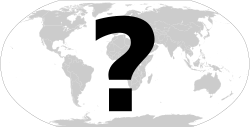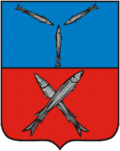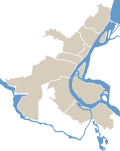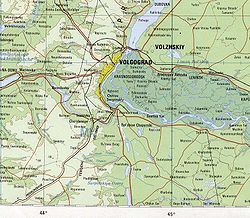Volgograd
Volgograd, formerly called Tsaritsyn (1589–1925) and Stalingrad (1925–1961) is an industrial city of great importance, and the administrative center of Volgograd Oblast, Russia. It is 80 km long, north to south, on the western bank of the Volga River and has a population of over 1.011 million people. The city was made famous for its heroic resistance and bloody siege during the Battle of Stalingrad taking place during World War II.
| Volgograd (English) Волгоград (Russian) | |
|---|---|
| - City[1] - | |
 Counterclockwise: The Motherland Calls, the railway station, Planetarium, The Metrotram, Panorama of the City, Gerhardt Mill, Mamayev Kurgan | |
 | |
| Anthem | none[2] |
| City Day | Second Sunday of September[1] |
| Administrative status | |
| Country | Russia |
| Federal subject | Volgograd Oblast |
| Administratively subordinated to | city of oblast significance of Volgograd |
| Municipal status | |
| Urban okrug | Volgograd Urban Okrug |
| Head[3] | Alexander Chunakov[source?] |
| Representative body | City Duma[3] |
| Statistics | |
| Population (2010 Census, preliminary) | 1,021,215 inhabitants[4] |
| - Rank in 2010 | 12th |
| Time zone | MSK (UTC+04:00) |
| Founded | 1589[5] |
| City status since | the end of the 18th century[1] |
| Postal code(s) | 400000–400002, 400005–400012, 400015–400017, 400019–400023, 400026, 400029, 400031–400034, 400036, 400038–400040, 400042, 400046, 400048–400055, 400057–400059, 400062–400067, 400069, 400071–400076, 400078–400082, 400084, 400086–400089, 400093, 400094, 400096–400098, 400105, 400107, 400108, 400110–400112, 400117, 400119–400125, 400127, 400131, 400136–400138, 400700, 400880, 400890, 400899, 400921–400942, 400960–400965, 400967, 400970–400979, 400990–400993 |
| Dialing code(s) | +7 8442 |
| Official website | |
History
Volgograd developed from the fortress of Tsaritsyn in 1589. The fortress was at the meof the Tsaritsa and Volga Rivers. During the Russian Civil War the city was the scene of heavy fighting. Bolshevik forces occupied it during 1918, but were attacked by White forces. It was renamed as Stalingrad in 1925.
Under Stalin, the city became heavily industrialized as a centre of heavy industry and trans-shipment by rail and river. During World War II, Stalingrad became the center of the Battle of Stalingrad as well as a turning point in the war against Germany. Essentially, the German offensive was stopped at Stalingrad. The Battle of Stalingrad lasted from August 21, 1942 to February 2, 1943, where 1.7 million to 2 million Axis and Soviet soldiers were killed, wounded or captured, in addition to over 40,000 civilians killed. The city was reduced to rubble during the fierce fighting, but reconstruction began soon after the Germans were expelled from the city.
Nikita Khrushchev renamed the city because of de-Stalinization in 1961.
International relations
Twin towns — Sister cities
As of 2008, Volgograd has 21 sister cities:[6]
 Coventry, England, United Kingdom (1943)
Coventry, England, United Kingdom (1943) Ostrava, Czech Republic (1948)
Ostrava, Czech Republic (1948) Kemi, Finland (1953)
Kemi, Finland (1953) Liège, Belgium (1959)
Liège, Belgium (1959) Dijon, France (1959)
Dijon, France (1959) Turin, Italy (1961)
Turin, Italy (1961) Port Said, Egypt (1962)
Port Said, Egypt (1962) Chennai, India (1966)
Chennai, India (1966) Hiroshima, Japan (1972)[7]
Hiroshima, Japan (1972)[7] Cologne, Germany (1988)
Cologne, Germany (1988) Chemnitz, Germany (1988)
Chemnitz, Germany (1988) Cleveland, Ohio, United States (1990)
Cleveland, Ohio, United States (1990) Toronto, Canada (1991)
Toronto, Canada (1991) Jilin, China (1994)
Jilin, China (1994) Yerevan, Armenia (1998)
Yerevan, Armenia (1998) Chengdu, China (1998)
Chengdu, China (1998) Kruševac, Serbia (1999)
Kruševac, Serbia (1999) Ruse, Bulgaria (2001)[8]
Ruse, Bulgaria (2001)[8] Huntingdon, Pennsylvania, United States (2003)
Huntingdon, Pennsylvania, United States (2003) Orlando, Florida, United States (2008)
Orlando, Florida, United States (2008) Baku, Azerbaijan (2008) [9]
Baku, Azerbaijan (2008) [9]
A number of communities in France and Italy have streets or avenues named after Stalingrad, hence Place de Stalingrad in Paris and the Paris Métro station of Stalingrad.
Gallery
| Wikimedia Commons has media related to Lua error in Module:Commons_link at line 62: attempt to index field 'wikibase' (a nil value).. |
Volgograd Media
Building of the Oblast Duma
References
- ↑ 1.0 1.1 1.2 Charter of Volgograd, Preamble
- ↑ Official website of Volgograd. Конкурс на создание гимна Волгограда будет проведен повторно (in Russian)
- ↑ 3.0 3.1 Charter of Volgograd, Article 22
- ↑ "Всероссийская перепись населения 2010 года. Том 1[[Category:Articles containing Russian-language text]][[Category:Lang and lang-xx using deprecated ISO 639 codes|ru]]". Всероссийская перепись населения 2010 года (2010 All-Russia Population Census) (in Russian). Federal State Statistics Service. 2011. Retrieved June 29, 2012.
{{cite web}}: Check date values in:|accessdate=(help); no-break space character in|accessdate=at position 9 (help); Unknown parameter|trans_title=ignored (|trans-title=suggested) (help); URL–wikilink conflict (help)CS1 maint: unrecognized language (link) - ↑ Энциклопедия Города России. Moscow: Большая Российская Энциклопедия. 2003. pp. 81–83. ISBN 5-7107-7399-9.
- ↑ Friendly relationship at Official website of Volgograd
- ↑ "広島市の姉妹・友好都市". City.hiroshima.jp. Archived from the original on 2009-06-07. Retrieved 2009-07-17.
- ↑ "Ruse Municipality - Fraternize Cities". © 2008-2009. Retrieved 2009-07-06.
- ↑ Executive power of Baku city
Other websites
- Official website of Volgograd (in English)
- (in Russian) Official website of Volgograd
- (in Russian) Volgograd.ru — City Web Portal, Local Business and Web Directory, News, Press, Webcams, 3D Mamayev Kurgan Archived 2020-12-08 at the Wayback Machine
- Over 2,000 original German WWII soldier photographs from the Eastern Front Archived 2007-12-13 at the Wayback Machine
- Sights of Volgograd Archived 2015-09-24 at the Wayback Machine
- Photo Gallery from Volgograd Archived 2008-12-21 at the Wayback Machine
- Stalingrad - Bilder einer erbitterten Schlacht (German)














